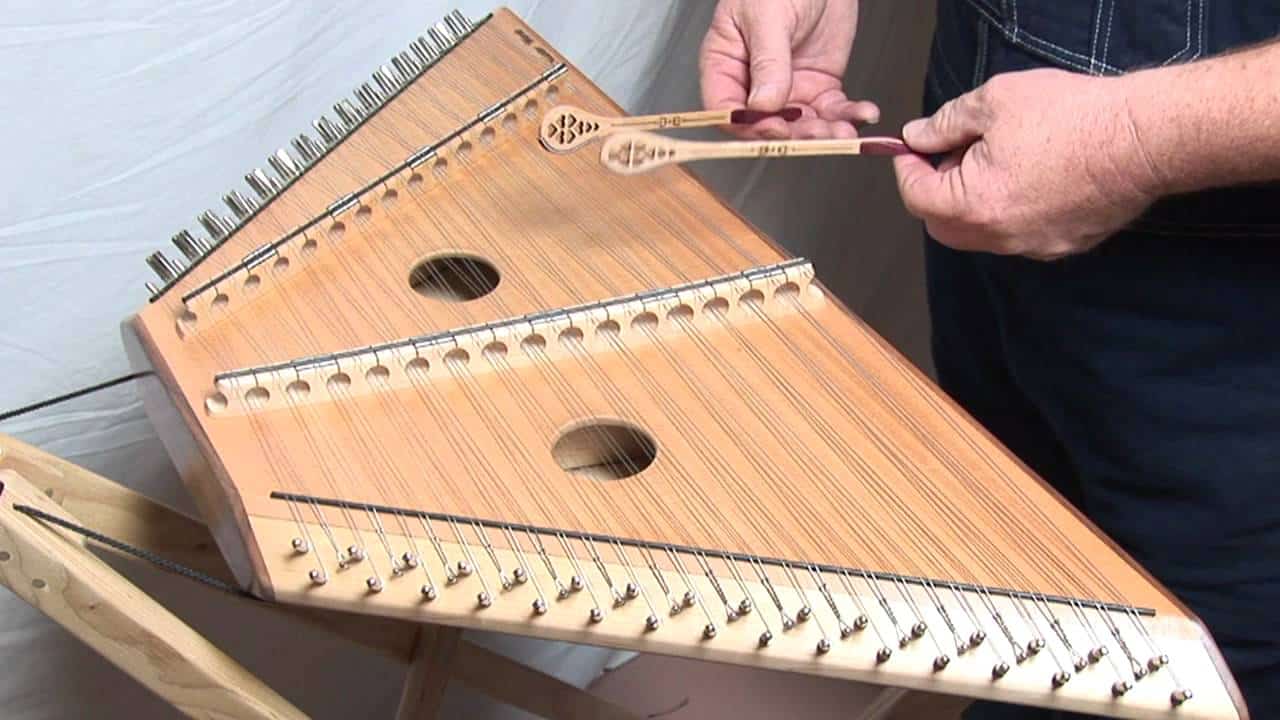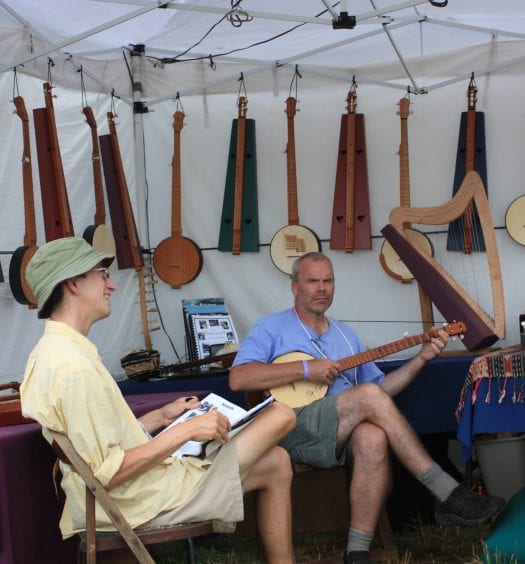There are many things to look for when selecting a hammered dulcimer. While some are important and relate to the construction and quality of the instrument, others are based on musician taste.
In general, the best advice we can give is to speak to existing owners of hammered dulcimers. You’ll find them to be quite a friendly bunch and more than willing to talk about their instruments (and even offer them for you to play).
Don’t know an owner of a hammered dulcimer? There are lots of ways to engage, either through a local club, a class, a festival, music shop and/or dealership. These folks should be more than able to guide you with their experiences. For those interested in purchasing a hammered dulcimer, there are a handful of things you should consider.
Soundboard Construction
The top of the instrument, or soundboard, is typically either constructed of solid wood (black walnut, mahogany, etc.) or plywood (laminate). As you have probably guessed, hammered dulcimers with solid wood soundboards are more expensive.
That said, there is little difference in overall sound quality these days, although some experienced players comment that sound from solid wood topped hammered dulcimers improves with age.
Type of Soundboard
What is a soundboard? The soundboard is the flat wood top upon which the bridges sit. As its name implies, the soundboard transfers the string vibrations to the rest of the instrument creating sound. The type of soundboard is a key distinguishing feature of the hammered dulcimer and can be either fixed or floating.
A fixed soundboard is basically glued to the body of the instrument and is not meant to be removed. In contrast, a floating soundboard sits on top of the instrument and can be removed once the strings are removed first.
The differences in sound quality between these two designs is subtle, although some players remark that a floating soundboard results in a crisper sound as the sustain is shorter in length. This can be useful, for example, for faster songs.
Wood Type
The type of wood used for the soundboard, as well as that used for the sides and back of the instrument, is a key factor in determining the tone. This is an important characteristic when selecting an instrument, but is based entirely on musician taste and preference.
It’s always best to play a hammered dulcimer in person, if possible, when comparing instruments.
Amount of Sustain
Sustain simply refers to how long the notes vibrate when the strings are struck. The type of wood used for the instrument, the internal bracing, as well as the type of soundboard (fixed vs. floating) all help determine the amount of sustain.
Some hammered dulcimer players install specialized dampers to better control the amount of sustain. Slower hymns sound great with more sustain, while quicker tunes (like jigs and reels) sound best with less sustain.
String Courses
Another important criteria when selecting a hammered dulcimer is the amount of string courses the instrument has. A course is basically a set of strings that are tuned to the same pitch. Typically, hammered dulcimers have 1-4 strings for every course.
A typical sized instrument will have 14 or 15 strings on the bass (right) bridge and 15 or 16 strings on the treble (left) bridge. This will give the player about 3 octaves to work with, in the keys of D and E.
Hammered dulcimers can range from 2.5 to 4 or more octaves, and are proportional to the size of the instrument. Some with 4+ octaves can start getting heavy, and so this should be factored in when selecting an instrument. Hammered dulcimers can also be chromatic, which allows for a longer range in the higher registers.
String Spacing
String spacing is another important feature of hammered dulcimers. Increasing the string spacing may make the instrument easier to strike the strings with a hammer, although this often results in larger, heavier instruments. Tighter spacing is preferred by some, although more precision is required with the hammers.
Generally speaking, string spacing is mostly musician preference and does not impact the overall sound quality of the instrument.
Size & Weight
Weight is an important characteristic to consider, depending on whether you intend to play at home or on the road. Some instruments can get quite heavy, particularly if constructed of solid wood with wide string spacing.
Master Works is a manufacturer of high quality hammered dulcimers based in Oklahoma that specializes in lighter than average instruments. Be sure to check them out.
Tuning Scheme
In the United States there are generally four tuning schemes: 5th-tuned, octave bass, piano dulcimer, and chord-based tunings.
The 5th-tuned scheme is by far the most common in the country, and is named as such because the notes across and between the bridges are in the interval of a 5th. Octave bass is popular in Michigan, while the other two are increasing in popularity.
Kits & Used Hammered Dulcimers
For those who prefer to build your own hammered dulcimer, there are many kits available online. These provide the ultimate in control in how your final instrument looks and performs, but may not be for everyone.
Used hammered dulcimers are also available – either through your local music store or online – eBay or other reputable marketplaces.
Hammered dulcimers are serious pieces of instrument, and buyers of used instruments should be on the lookout for fakes, poor construction, and/or deteriorating conditions.
First, ensure the tuning pins are stable and are able to keep tune. This is critical, because if the instrument cannot stay in tune you simple won’t be able to play. Yes, this is obvious – but older instruments sometimes exhibit this problem, so ask questions and play the instrument in person if you can.
And second, always ensure the soundboard is intact and not cracked or warped. Not only will this reduce the resale value of the instrument, but it will also affect the sound as well.
Conclusion
Hopefully this article will help you in deciding what to look for when selecting a new or used hammered dulcimer. Having the ability to test drive some instruments in person – either though a local club, a class, festival, or dealership – is your best bet. But if not, there are some great choices available online.
And for those who prefer ultimate control over the final product, there are kits available as well. Building your own instrument is not for everyone. But if you have the time, experience, and equipment, building your own hammered dulcimer could be extremely rewarding.
One outstanding option that we particularly like is the Roosebeck Double Strung 10/9 Hammered Dulcimer w/ Hammers. Both beginner and experienced players alike have positive things to say about this instrument. Regardless of which instrument you choose, you’re making an investment in yourself and your musical journey so enjoy the ride.
Interested in learning more? Check out our post on the history of hammered dulcimers.




